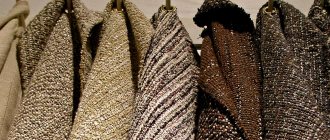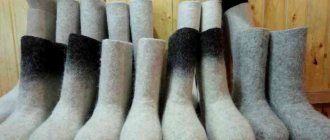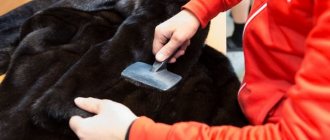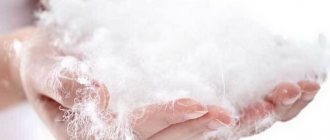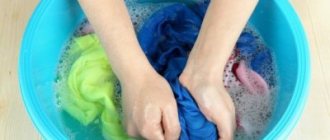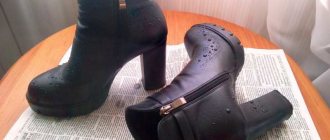Synthetic insulation has long been used as insulation for autumn and winter clothes. Environmental friendliness, manufacturability and the ability to reduce the thickness of a product without compromising thermal properties led to the emergence of padding polyester, holofiber and other materials that were originally used for sewing sportswear and work clothes. Overalls or jackets that use Thinsulate as an inner layer have excellent thermal insulation properties, are lightweight and last a long time. Like any clothing, down jackets need care, and in order to do it correctly and not spoil an expensive item, it is useful to familiarize yourself with the basic rules of washing, drying and storage.
Machine washable
How to properly care for clothing with Thinsulate is indicated on the product label. Typically, you should wash Thinsulate insulation in a machine according to the following rules:
- prepare the item for washing (see above);
- set the “delicate wash” or “hand wash” mode;
- the temperature should be from 30 to 40 degrees;
- spinning should be done at minimum speed;
- you can add a cap of fabric softener (to soften the material);
- increase the number of rinses so that the Thinsulate is completely rinsed;
- If several things can easily fit into the drum of the machine, then you can wash them at the same time.
Machine washable
When washed in an automatic washing machine, the heat-saving and other useful qualities of the material will be preserved for a long time.
What to do if the filler has fallen off, how to restore the shape of the item?
When this problem occurs, the question arises whether it is possible to fluff up the matted filler yourself. There are 3 ways out of this situation:
You can return the material to its original appearance using a vacuum cleaner. Having removed the dust collection nozzles from its hose, you need to turn on this device at minimum power
After this, you need to carefully move the tube along the wrong side of the product. Particular attention should be paid to those areas in which the most holofiber has accumulated. Repeated rinsing of the product 2–3 times will help fluff up the filler. To achieve maximum results, it is recommended to place 3-4 tennis balls in the washing machine drum. After rinsing, the wet item should be rolled into a tight bundle and placed in the freezer
Microscopic ice crystals, into which drops of water transform when exposed to low temperatures, will give the holofiber its original volume. Try to distribute the matted material with your hands. To do this, you need to knead all the areas where there are lumps.
Proper care and washing
After the launch of mass production of Thinsulate insulation, sportswear began to be produced with this material in large quantities, especially ski suits, and they even developed a large range of modern model clothes for everyday wear. A range of items for adults and children are now on sale. They began to produce jackets, coats, overalls, and even bedding with Thinsulate insulation: blankets and pillows, as well as shoes.
Machine washable
IMPORTANT! Thinsulate is an artificial material that is resistant to high temperatures. Before washing or ironing a product, read the instructions or label on which the manufacturer indicates how to care for this item.
- If you are going to wash a bulky item such as a blanket or pillows, make sure your machine can handle the weight and volume.
- Before placing the item in the washing machine drum, check it for stains. If there are any, they must be cleaned before the main wash. You will need: a sponge and a soap solution. There is no need to rub or treat such a product with any aggressive detergents, since Thinsulate is easy to clean. It is not able to absorb and retain moisture, and therefore dirt.
IMPORTANT! Chemical stain removers, as well as products containing bleaches and chlorine, should not be used.
Check the contents of your pockets and shake out all small debris. Turn the garment inside out and fasten all zippers, zippers and buttons fully. If there are fur parts that can be detached, remove them. Fur trim should not be machine washed. If your clothes have permanent parts made of natural fur, wrap them in a cellophane bag and tie them with thread or rope
It is important that the fur does not interact with water. Expensive or, conversely, low-quality accessories can be protected from damage in the drum during washing by wrapping them with stationery tape. Along with the product, place several clean tennis balls in the washing machine drum. This is necessary so that during the washing process the filler does not form lumps and is distributed evenly. For such bulky items, it is better to choose liquid detergents. Washing gel or special capsules that are placed in the drum of the machine along with the clothes are suitable. To remove excess static from the product, you can use conditioner when rinsing. Set the washing cycle to a delicate cycle at a temperature not exceeding 40°C. For such bulky items, an additional rinse is required, at least two cycles.
Washing gel or special capsules that are placed in the drum of the machine along with the clothes are suitable. To remove excess static from the product, you can use conditioner when rinsing. Set the washing cycle to a delicate cycle at a temperature not exceeding 40°C. For such bulky items, an additional rinse is required, at least two cycles.
Tip: if your item has any stubborn stains or is very dirty, we recommend soaking it in a warm soapy solution for a couple of hours before washing. Particularly dirty areas can be cleaned with a soft soapy sponge. After such procedures, you can wash the item either manually or in a washing machine.
- The Spin program should not exceed 600 rpm.
- We do not use the “Drying” function.
Hand wash
If the drum capacity of your washing machine does not allow you to wash such items or you do not trust expensive clothes to your machine, then you can wash them by hand.
Washing by hand is no different from washing in an automatic machine. The process is similar, with the exception of some details. Do not pour washing powder directly onto the product. As a rule, it is first completely dissolved in warm water not exceeding 40°C, and then the prepared item is dipped into a container with a washing solution (the item is prepared for washing as described above). Still, it is better to use delicate liquid compositions, which, unlike washing powders, are well rinsed from the fibers of the material.
When washing, do not be too zealous. Due to its water-repellent qualities, the material is perfectly washed from various contaminants.
IMPORTANT! If your items cannot be cleaned at home, we recommend contacting a dry cleaner for help. In any case, this is better than if you start doing untested experiments on your things
A little theory
The amount of thermal energy generated by a person depends on the person’s individual characteristics, well-being, and even on how well he ate and slept. The role of clothing with insulation is to preserve this same energy. Thermal insulation is the process of reducing heat transfer between the body and the environment. It is not for nothing that insulation in English is always defined by the word Insulation - insulation. A vacuum environment has minimal thermal conductivity, and the most accessible heat insulator with low thermal conductivity is dry air. It is dry, since moisture is a good conductor. The more air molecules the insulation holds in one cubic centimeter, the better its thermal insulation properties. Air is always in motion - warm air tends to rise, cold air goes down; this factor must also be taken into account when developing insulated clothing. Thus, the main task of clothing insulation is to keep the air warmed by our body inside, and not to let cold air outside. Important quantities that allow us to describe the qualities of insulation:
R-value
– the value of the thermal resistance of the insulating layer. Reported in CLO. The higher the R-value, the better the thermal insulation properties of the material. Fill Power (FP)
– the most common indicator of the quality of insulation (usually natural down).
This characteristic shows the ability of the insulation to recover after compression. The higher the FP index, the warmer the product for the same weight of down. Some companies working on the European and American markets sometimes indicate the double value FP-750 FP Euro, 850 FP USA. This is due to the fact that quality standards in these zones are slightly different. By the way, all synthetic analogues have characteristics similar to FP600 fluff. One of the most important characteristics of insulation is the value of thermal resistance per unit weight of insulation
.
This indicator determines how heavy the insulated jacket will be for specific temperature conditions. Durability
is an essential characteristic, especially considering the considerable price tag for high-quality insulated clothing.
For example, cheap insulation materials can fall off and cake over time, changing their density, which leads to a decrease in thermal insulation properties. Perhaps someone noticed that after washing, some insulated products retained heat an order of magnitude weaker. Hydrophobicity
(describes the interaction of a material with water).
Synthetic insulation, as a rule, is not hygroscopic, i.e. do not retain moisture. The same cannot be said about fluff. For insulation to be as versatile and effective as possible, it must retain heat in humid conditions. Compression ability
.
One of the most important tasks for outdoor workers who are assembling a backpack is to choose equipment that is as light and compact as possible. The most important advantage of down products is their minimal volume when folded. Modern synthetic insulation may be inferior to down in terms of compression, but they are definitely close to it. Often a vest or jacket can be folded into its own pocket. Elasticity
. In relation to insulation materials, this is the ability to restore the original structure, actually volume. The structure of synthetic fibers is most often restored faster than fluff. This is partly why down jackets often have inserts with synthetic insulation in the shoulder area and on the sides of the jacket, where the greatest pressure is exerted.
Preparing for washing
First, carefully study the label:
- Is there a picture of an automatic machine? Feel free to use it. The jacket is machine washable.
- Is there a basin and a palm on the label? No machines, wash by hand. We don’t twist it, we don’t rub it, we don’t squeeze it.
- The numbers on these pictograms will tell you at what temperature to process.
- Square - can be pressed in a centrifuge. A crossed out square means automatic spinning is prohibited.
- A square with an inscribed circle can be wrung out and dried in a machine.
- Circle - the manufacturer recommends chemical cleaning.
Did you find out that the jacket is washable? Great.
- Unfasten everything that can be detached: the lining, the hood, the fur trim. It is better to wash small parts by hand or not wash them at all.
- Fasten all zippers, fasteners and buttons.
- Turn the jacket inside out.
This way you will protect the product from possible damage: the buttons will not come off, and the shiny rivets will not be scratched. In addition, some cleaning products sometimes leave light streaks and stains on the fabric. If this happens to your jacket, let the stains remain on the back of the item.
How to remove stains from polyester outerwear
100% polyester fibers do not absorb pollutants. If you spill juice or coffee on your jacket, wipe the stained area with a damp cloth and the fabric will clean.
The only exception is grease stains. You can't do without a stain remover here. But polyester does not tolerate bleaching, so read the label on the bottle carefully. It should indicate for which fabrics the product can be used.
- Is there no such information? Refuse to purchase.
- There is a list of fabrics, but polyester is not mentioned there? Look for a different stain remover.
If you haven’t bought a suitable product, try regular laundry soap:
- Wet the stained area.
- Rub it with laundry soap.
- Leave for 20-30 minutes.
- Wash the soapy fabric with warm water.
Do not rub polyester with a brush under any circumstances - this will leave light spots and “shaggy” appearance on the material.
What to do if you are not sure about the safety of the stain remover
There are situations when a stain needs to be washed off “right now,” but there is only one bottle of stain remover at home, and the label has long since come off.
This simple test will tell you if the cleaner can be used on polyester.
- Moisten a cotton swab with stain remover and wipe the product in an inconspicuous place: on the inside seam, on the hem of the sleeve, on the wrong side of the zipper.
- Wait the time indicated in the instructions, rinse the jacket and dry it.
- Evaluate the result.
We recommend: How to remove gray and yellowness from white things at home?
If there is a light stain on the fabric and the dye has transferred to the tampon, the bleach is too aggressive. It cannot be used to clean a jacket.
Choosing a detergent
Washing powder for a jacket or coat is not suitable. It is very difficult to rinse out solid fractions from dense polyester; moreover, they will settle in the insulation and on the lining. You don't want to wear clothes soaked in chemicals, do you?
To wash a polyester jacket, use liquid detergents and gels
Pay attention to the following points:
- The detergent must not contain chlorine or other bleach.
- The gel should dissolve in cool water. Many manufacturers recommend washing polyester jackets at a temperature of 30-40 o, keep this in mind.
And don't forget about the antistatic conditioner! Polyester outerwear is easily electrified. A good air conditioner will solve this problem.
How to wash membrane polyester
Be especially careful when washing membrane polyester!
The powder clogs the “pores”, and outerwear loses its unique properties. Therefore, use only special products designed for membrane materials.
Such things are dried exclusively in a horizontal position. Place membrane products away from direct sunlight and heating devices.
After washing, be sure to treat the jacket with a special impregnation - it is sold in sporting goods stores. This is the only way to preserve all the beneficial properties of the fabric.
Ironing
It is advisable to avoid this procedure. If there is a need for ironing, then use a “cold” iron. It is not advisable to heat it above 40-60°C. When ironing, you need to move the iron carefully, without pressing it too hard against the surface. It is best to arrange the items immediately after washing so that they are as even as possible, without wrinkles, and not wrinkled. Then you won't need ironing. For severe wrinkles, it is recommended to spray them with water from a spray bottle, straighten them and dry them again.
In general, there should be no problems with how to wash things made from Thinsulate. This is an unpretentious insulation material that can easily withstand all types of washing and dries quickly after getting wet. If all requirements are met, items can be washed many times without compromising quality.
Washing Thinsulate
Items sewn using this material can be washed both in an automatic machine and by hand. The insulation tolerates both well. However, there are some features that need to be taken into account. Before washing Thinsulate, you need to look at the label to see what the item’s washing and water requirements are.
Handwash
Washing Thinsulate by hand does not require any special steps. First, the item is soaked in warm or slightly cool water (within 30-40°C). In this case, you need to select a container so that it matches the dimensions of the clothing, so that the latter lies freely and is straightened: wet Thinsulate does not like squeezing and squeezing. Therefore, it is best to wash winter clothes for an adult in the bath. Children's overalls and jackets are in a large basin.
If the item is heavily soiled or there are individual stains, they should be pre-washed. Typically, collars, cuffs, hems of trousers and the area around pockets need this.
For washing, it is best to use a liquid product, for example, a special gel. It is dissolved in warm water. Then the clothes are placed in the container. You can beat it a little under water with detergent. The item must be completely covered with water, otherwise the inner layer will not get wet. After a few minutes, the clothes are carefully washed by hand. Heavily soiled areas (collar, cuffs) can be scrubbed with a brush. When all the stains have been washed, the item is taken out of the water, allowed to dry a little (you cannot twist or squeeze the Thinsulate!) and rinsed in cold water. To do this, the clothes are dipped several times in a container of clean water. You need to rinse thoroughly so that the detergent is washed out and no soapy streaks remain.
Machine washable
Many people are interested in whether Thinsulate can be washed in a washing machine. The answer to this question can be affirmative. This insulation is unpretentious and does not require special treatment. Thinsulate can be safely washed in an automatic washing machine. However, there are some requirements for the regime that must be met. Then the clothes will endure several dozen washes without harming themselves and without losing their heat-saving properties. How to wash Thinsulate in a machine:
- water temperature for washing – 30-40°C;
- use delicate or hand wash mode;
- use only liquid laundry detergents;
- spin at minimum speed (within 400-600 rpm);
- It is permissible to use fabric softener; it can soften the insulation, which will extend its service life;
- install an additional rinse so that the washing gel is completely washed out of the numerous pores of the insulation, and soap stains do not appear on the clothes;
- You can wash your Thinsulate down jacket with other items.
If there are stubborn stains, there is a risk that they will not be washed in the machine. Therefore, you need to wash them by hand first. You can use the same gel that will be used for machine washing. Do the same with greasy elements, for example, with cuffs.
If you follow these tips, the insulation will easily withstand automatic washing.
Dry cleaning
Another issue that especially worries owners of hiking suits is the possibility of dry cleaning the product. Thinsulate tolerates treatment with aggressive substances. If dry cleaning is necessary, more attention should be paid to the material of the top and outside. In most cases, this procedure is acceptable for down jackets made of Thinsulate. Therefore, large items or if there are complex stains that cannot be washed off, it is better to take them to a dry cleaner, where various contaminants will be removed using professional equipment using special products.
Do down jackets need to be washed?
The correct answer to this question requires an individual approach. Some people “wipe” their down jacket every day on public transport and at work, while others carefully use it only a couple of times a week. Some have natural down stuffing inside the product, others have holofiber or thinsulate. Some people buy a warm item for two winters, others plan to wear it for at least 4 years.
Afraid of ruining their favorite jacket, many people think about dry cleaning the product. But several obstacles immediately appear. Not every locality has a company providing this type of service. And if there is, then the cost of services and the lack of guarantees confirming the preservation of the appearance of the down jacket are unlikely to please. Therefore, after carefully reading the instructions, entrust your down jacket to the washing machine, and return it to its former shine at minimal cost. Perhaps, after three years, your down jacket will go out of fashion, and you will be happy to replace it with a more stylish warm jacket.
Thinsulate coat: features
Depending on what weather and temperature you are going to use your clothes for, you should choose one or another type of Thinsulate insulation. What does this mean? The fact is that there are several types of Thinsulate.
- Flex is used in activewear and workwear where increased stretch and flexibility are required.
- Classic Comfort is intended for sports uniforms, as well as for insulating gloves.
- LiteLoft's compression resistance makes it ideal for outdoor gear.
- Ultra is used in outerwear and ski suits.
- Ultra Extreme Performance for Footwear is the thickest of all types of Thinsulate, designed for equipment for extreme sports enthusiasts, with maximum heat-saving effect.
In general, there are three main modifications of Thinsulate: without a shell, with a shell on one side and with a double-sided shell. The first type is used mainly when sewing outerwear such as jackets and trousers. The fibers are held together with glue. Thinsulate with a one-sided shell is recommended to be quilted every 15-20 cm. The side that has the cover in the products faces the lining.
The insulation with a double-sided shell has a quilting step of 15 cm. It is convenient for work and is used when sewing coats and winter jackets. Moreover, no additional stitches are required for the product; the material is attached to the seams of the product.
Modern winter clothing designers are literally fascinated by the ability to create coats with a form-fitting silhouette. This was made possible thanks to a thin layer of Thinsulate insulation. The photo shows how elegant winter clothes can be with this lining. Even with a thickness of only 3-6 mm, they protect no worse in severe frosts
Models can be chosen to suit every taste: with and without a hood, long and short, with extravagant trim and classic. Thanks to Thinsulate, winter clothes are now not only warm, but also elegant and practical.
It turns out that it was invented back in the seventies of the twentieth century for polar explorers, astronauts and athletes of the Olympic team. It is noteworthy that for the production of Thinsulate, equipment was initially used that was intended for heating and kneading the mass for the production of adhesive tape.
Since this insulation is now considered the lightest, manufacturers use it to make outerwear and sportswear, as well as blankets and sleeping bags, because such travel accessories take up less space in a backpack.
We suggest you read: Winter boots creak when walking, what to do
Since you can play sports in clothes made of Thinsulate even at minus 25, and children in suits made of this material actively explore the entire surrounding space, sooner or later the question arises: how to wash Thinsulate?
| washing mode | delicate |
| water temperature | no higher than 30-40 degrees |
| spin | no more than 600 rpm |
| drying | at room temperature |
- For washing, it is preferable to use liquid detergents (the powder may leave yellow stains on a light-colored jacket).
- You can use conditioner.
- To better rinse your Thinsulate jacket, you can turn on the extra rinse mode.
- On light-colored clothes, the sleeves get the most dirty, and at low temperatures they may not be washed. Therefore, it is better to wash the most contaminated areas in advance or scrub them with a stiff brush before washing.
- The most important thing is that Thinsulate can be dry cleaned! It is not surprising that clothes for tourism, hunting and fishing are made from it: the dirtiest things, ultimately, can be taken to the dry cleaner without harm to them.
This insulation, due to its universal properties, is widely used not only in sewing clothes. It is good for the production of winter clothes because, due to its small thickness, it allows you to create close-fitting silhouettes of winter coats. Fashionistas are already tired of shapeless, voluminous down jackets, because they want to emphasize the slimness of their figure, but in winter this was practically impossible to do. Now winter clothes are becoming not only practical, but also elegant.
The only thing that so far limits the widespread use of Thinsulate clothing is the price, which is steep. After all, clothes containing such modern insulation cost 2-3 times more than a regular down jacket. There is one consolation: thanks to their durability and ease of care, such clothes will last much longer, which means you won’t have to buy a new overall for your child every year, and another ski suit for yourself.
Thinsulate insulation
Thinsulate is the development of such an innovative giant as 3M. To be honest, it was developed in 1979, but, nevertheless, is still actively used in the production of clothing and footwear. Without going into too much technical detail, Thinsulate is a material made from particularly thin synthetic fiber with a thickness of 2 to 10 microns.
Each fiber is naturally surrounded by a layer of air, which ensures that the human body retains heat. Since the fibers are thin, the fabric itself is not very heavy and thick. Also, one of the practical characteristics of Thinsulate is that such material practically does not absorb moisture and does not become damp. In addition, Thinsulate washes well, is resistant to compression and mechanical deformation, and can then return to its original shape. As a result, Thinsulate is quite good at competing with natural insulation materials such as goose down or wool, which are much more hygroscopic, less resistant to aggressive use and significantly increase the size of clothing.
Thinsulate from 3M is available in several varieties:
- Thinsulate Platinum Insulation - used mainly in the production of casual outerwear, clothing for active recreation and outdoor activities; Thinsulate Platinum Insulation Flex - has increased elasticity and the ability to stretch up to 40% of the original size. Mainly used in the production of sportswear.
- Thinsulate Platinum Insulation X-STATIC is a material with antimicrobial and deodorizing properties. According to the manufacturer, it contains silver threads, provides antibacterial protection, and prevents the formation of unpleasant odors. It is used both in the production of regular and in the production of sportswear or shoes;
- Thinsulate Platinum Insulation FR is a material with fire-resistant fibers that can withstand short-term exposure to fire or electricity. Used in the production of work clothing.
- Thinsulate Ultra is a type of insulation designed to retain heat in the coldest conditions. It has increased wear resistance and the ability to withstand repeated physical impacts. Used in the production of winter shoes.
Manufacturers of clothing and footwear that use Thinsulate insulation: La Sportiva, La Crosse, Wolverine, Chippewa, Rocky, Mason Shoe, Hodgman, Carhartt, Merrell, Timberland, Wrangler, Sorel and many others.
Why do you need home washing?
There is an opinion that this option for caring for a winter jacket is something outdated and even dangerous. Adherents of this theory always prefer to take things to the dry cleaner, even if this has to be done several times a season. Sometimes this method of cleaning a down jacket is recommended exclusively, but in some cases you can remove dirt at home. Below are the advantages of this approach:
- Significantly cheaper. A trip to the dry cleaner can be ruinous if several people in the family wear down jackets.
- No need to bother with finding a dry cleaner. In megacities, there are collection points in many shopping centers, but what should residents of smaller cities do? The required service is not always available right next door.
It is also worth noting that some dry cleaners insist on signing a receipt-agreement stating that the client has no complaints in any case. Therefore, if you still decide to turn to professionals, we strongly recommend that you re-read this paper several times. As a rule, these documents, drawn up by lawyers with solid experience, set the goal of minimizing the damage to the company as much as possible if something goes wrong. That is, you, of course, can then sue, but it will be very difficult to prove guilt.
Basic rules of care
Thinsulate outerwear is lightweight, durable, and retains heat well. That is why owners of products with a technologically advanced and modern type of filler want to preserve the beneficial properties of the material for a long period.
Since this insulation is new, many housewives do not know how to properly care for it. If everyone has long learned to wash down and padding polyester items, then in this case many questions arise
First of all, it is important to study the label - the jacket manufacturer indicates there the basic rules for washing and drying the product on Thinsulate.
So, you should wash outerwear with modern insulation, following a number of recommendations:
- the water temperature should not exceed 40°C, otherwise the product may lose its shape;
- Before loading into the drum, be sure to remove stubborn stains on the sleeves, collar and pockets of the jacket. This can be done with a sponge soaked in a soap solution;
- Be sure to turn the product inside out, unfasten the removable decorative elements and fur;
- all zippers and buttons must be fastened;
- It is better not to use dry powders; preference should be given to gels;
- when washing automatically, be sure to set one of the delicate modes programmed in the intellect;
- do not neglect the option of additional rinsing;
- the soaking time of the item should not exceed 1-2 hours;
- spinning is allowed, but at a speed of no more than 400 rpm. It is better to remove excess water manually;
- drying should be carried out away from heat sources, in a well-ventilated room. The down jacket is straightened out on the “hangers” and hung on a dryer or rope.
In fact, the rules for caring for outerwear made from Thinsulate are almost no different from the recommendations for washing items made from synthetic materials.
It is important to monitor the mode, water temperature and spin speed. If you follow the instructions, the automatic washing of your down jacket will please you with the results.
Interesting:
- What mode should I use to wash a down jacket in a Samsung washing machine?
- How to wash a winter jacket in the washing machine
- How to wash a down jacket in an automatic machine?
- How to fluff a down jacket after washing at home
- Washing padding polyester in a washing machine
- In what mode should I wash a down jacket in a Bosch washing machine?
Reader comments
Share your opinion - leave a comment
You also need to dry it properly
In order to ensure the cleanliness and functionality of a down product, it is not enough to wash it correctly. Proper drying will help to finish the job you started and keep the down jacket in its original appearance.
The following recommendations will help you dry your washed item without loss and return it to its original appearance.
If your home appliances are equipped with a dryer, you can use it to dry your down jacket. But this drying method is not recommended due to the fact that the thermal insulation properties of the product may deteriorate.
If the choice is made in favor of this method, then a mode is set for drying synthetic materials. The air temperature should not exceed 30 degrees. After drying, the jacket is hung on hangers in a well-ventilated area and shaken periodically, “fluffed” like a pillow, shaken “upside down,” etc. These activities will allow the filler to fluff up and be evenly distributed throughout its cells.
First you need to unfasten the buttons, zippers, and rivets. The down jacket itself does not need to be turned out until it dries. It is recommended to hang the washed product on hangers in a well-ventilated area in a warm place, but not on heating devices! As the jacket dries, it is necessary to periodically shake, “beat” and shake.
If after washing it was not possible to avoid the formation of lumps, you can restore the down jacket by taking it to the dry cleaner. Or restore the filler by re-washing the product according to all the rules with special balls.
photo: depositphotos.com/AnmFoto, amnachphoto, Joe-L
Pros and cons of Thinsulate
Thinsulate is an artificial insulation material. Polyester fibers are used as the base material. A feature of the fiber structure is its spiral shape. To give the material plastic properties, it is treated with a silicone compound.
Thinsulate is actively used for sewing outerwear and sports suits. Initially, the material was planned to be used only for making suits for astronauts. Later, Thinsulate began to be used on a large scale.
Positive properties of insulation:
- Hypoallergenic.
- Easy to care for.
- Moisture-repellent ability.
- Long-lasting thermal insulation.
How to wash a coat or jacket with Thinsulate?
Since the 2000s. Thinsulate is gaining popularity as insulation for jackets, coats, down jackets, overalls for winter sports or everyday wear. In this regard, the question arises, how to wash things with this synthetic filler at home, without sending them to the dry cleaner, and without damaging the product?
Rules for washing in an automatic machine
The easiest way to wash things, which does not require much effort, is automatic washing in a machine. Is this method suitable for winter clothes filled with Thinsulate? Yes, Thinsulate tolerates machine washing well, but in order for the product to retain its original appearance, you must follow the rules of washing, spinning and drying.
Which mode and temperature should I choose?
Thinsulate tolerates machine washing well, so you can safely wash jackets and down jackets in automatic mode. The advantage of this filler is that it does not fall off or form lumps, so it is not at all necessary to take things to the dry cleaner.
Before loading a coat or jacket into the washing machine drum, you should familiarize yourself with the care rules:
- the toggle switch of the automatic machine should be set to delicate mode;
- the water temperature should not exceed 40°C;
- After the main wash, the item should be rinsed several times - this will prevent the appearance of soap stains.
What detergent should I use to clean the lining? Do not use washing powder in granules. For gentle cleaning, it is recommended to use liquid products. If there is a dirty stain on your clothing, you must first rub the area with soap and then load the product into the machine.
The down jacket can be washed together with other things, if the drum of the automatic machine allows it. However, you should not load wool or silk fabrics with winter clothes; they may become damaged during washing.
Is it possible to squeeze?
How do things with Thinsulate survive the spin cycle? Down jackets and down jackets can be wrung out automatically; this will not damage or deform the item. At the same time, you should not turn on the spin cycle at maximum speed. As in the case of the washing mode, you need to spin in a delicate mode, the permissible number of revolutions is 400–600.
If there are concerns about automatic spinning, then this can be done manually. There is no need to hang wet clothes on the dryer, just gently wring them out with your hands, without excessive curling.
Features of hand washing and spinning
How to properly wash an item with Thinsulate by hand? First of all, you need to choose a container in which the coat or down jacket will fit completely. The best solution for these purposes is not a basin, but a bathtub.
The bath is filled with warm water, the temperature of which does not exceed 40°C, and liquid detergent is poured. After it dissolves in water, the item is lowered there so that it is completely immersed
It is important to wait until the top layer and filling are wet before starting to wash. Contaminated areas are scrubbed carefully, without sudden movements.
Particularly dirty places are additionally soaped and rubbed.
When washing by hand, you need to rinse the item several times. To do this, you need to drain the soapy water from the bath and pick up clean water, repeat this procedure 2-3 times. The soap must be completely washed out of the Thinsulate, otherwise white streaks will remain on the clothes.
When spinning by hand, there is no need to twist the clothes and wring them dry. It is enough to squeeze the item with your hands a little so that excess water drains, and then hang it over the bathtub.
How to wash polyester outerwear in automatic mode
Today, most housewives prefer machine washing. It's convenient, fast, and doesn't require any labor. Using the delicate washing mode, you can wash even problematic items, including jackets and down jackets.
To know exactly how to wash a polyester jacket in an automatic washing machine, you need to study the label, which contains recommendations from the manufacturer, taking into account the characteristics of the fabric and filling. In most cases, the product can be machine washed by setting certain temperature and spin parameters.
Before you start washing, you should prepare the product:
- Check all pockets to avoid cases of valuables being washed.
- Unfasten all parts that are possible and which cannot be washed (as a rule, the hood or detachable fur rarely gets dirty) or which can be washed by hand (for example, a collar).
- Check the jacket for stains and heavily soiled areas. They must be washed using laundry soap or stain remover.
- Place the jacket in the drum of the machine. If you need to wash a down jacket, you should put a few tennis balls with it to prevent the down from forming into dense clumps.
- Add detergent (it is better to use gels rather than powders) and rinse conditioner.
Washing modes
A jacket, and even more so a down jacket, are wardrobe items that require special treatment. In order for the product to last for more than one season, you should take care of how to wash a polyester down jacket in the washing machine correctly and with the least risk.
As a rule, polyester jackets do not tolerate strong mechanical stress, so the washing cycle is set to delicate. This means that the drum will make fewer rotations, and the spin will be minimal. If the spin parameters are set independently, then the limit of 600 revolutions cannot be exceeded. For down jackets it is even less - up to 400 rpm.
Required temperature
Polyester, like any synthetic fabric, does not like high temperatures. That is why for jackets labeled 100% polyester, the washing temperature should not exceed 40 degrees. However, a pure synthetic composition is rare - manufacturers prefer mixed materials with natural fibers. If the label says that the fabric consists not only of polyester, but also of cotton, you can set the temperature to 60 degrees.
